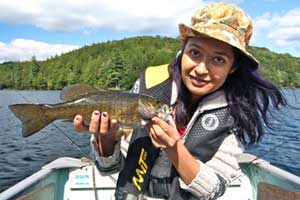Smallmouth Bass Deep Water Fishing

In the summer months as the water temperature increases above the Smallmouth Bass’ normal temperature range, they move from the shallow waters in to the deep. Smallmouths change their depth quite often and can be found in ranges from shallow waters to waters as much as 30 feet deep. They can move feeding locations many times during the day.
A sonar-based depth finder is highly effective at locating them when they go deep.
- Use heavier gear
- Your line should be between 8 and 14 pound test
- Use deep-diving crank baits and lures resembling small rainbow trout
See our section of various electronic tools to help you search for bass when they go deep.
However as we enter fall the water cools off. This brings them back to shallow water before heading back to the deep later in fall.
You may need to let your line out as much as 100 yards when trolling for deep-water bass. And as tension between the rod and the lure is weak, hold the rod in your hands instead of using a holder for better sensitivity.
Standard holders won’t indicate any light strikes with 100 yards let out.
Fishing Technique
Food is their primary reason for changing depth. They can be lured into the depths by schools of small fish or found grazing the rocky shallows for crawfish.
- Standard Smallmouth lures include artificial worms and small split-tail plastic grubs.
1.Weight the lures and retrieve them with little hops along the bottom.
When they’re following artificial lures, but hesitant to strike, try crawfish, minnows, hellgrammites, or night crawlers.
Crayfish is a top bait all year round and the most effective at generating strikes. Hook it near the end of its tail.
2. Retrieve the crawfish at a slightly faster, hopping pace, to prevent the crawfish from burrowing under rocks.
3. Alternatively use a shiner hooked through both lips.
- Use a number 4 and number 6 hook attached directly to the line, with a light split shot weighted to bring the bait to the bottom.
- Work the shiner slowly
4. Try top-water fishing at dawn or dusk at any location where smallmouth bass are found during the day. Experiment with long, slender floater-divers and larger lures cast off rocky points in water 30 or more feet deep.
Smallmouth Bass produce spectacular twists and jumps the second the lure hits the surface or moments after the lure lies motionless.



